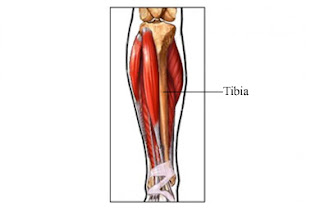Lower Leg Injuries and Exercise, 2
Shin splints are much more than shin soreness. Shin soreness happens through overuse of your shins during training. Soreness can be treated with the R.I.C.E.R. principle (REST, ICE, COMPRESSION, ELEVATION, REFERRAL FOR MEDICAL ASSISTANCE). Shin splints refer to a medical condition called Medial Tibial Stress Syndrome (MTSS).
Problems with your tibia (shin bone), fibula and the many muscles that attach to them cause shin splints. There are two main causes of shin splints:

1. Overloading - Exercising on hard or uneven surfaces bring on shin splints. Other common causes of shin splints are exercising with cheap shoes, exercising after a long layoff, a sudden increase in exercise intensity/duration and excessive uphill or downhill running.
2. Biomechanical Problems - The most common biomechanical problem is running with flat feet which leads to over-pronation (foot and ankle roll excessively inward) and splints on the medial or inside of the shin. Poor running mechanics can also lead to shin splints.
And, finally tight lower leg muscles (anterior tibialis muscles and calves) contribute to shin splints (usually lateral, or outside of your shin).
Prevention of shin splints includes the following:
1. Quality footwear is a must. You may need the recommendation of a podiatrist and/or expert footwear salesman.
2. Proper warmup of your lower leg muscles and tendons before your activity.
3. Proper running mechanics will help prevent shin splints.
Treatment of shin splints include:
1. R.I.C.E.R. application during the first 24-72 hours of injury.
2. After 72 hours of ice treatment, use heat and deep tissue massage. You can also massage the shin area before and after exercise activity.
Prevention of shin splints is the best policy!
Be sure and download your Free Bodyweight 500 Metabolic Fat Burner Workouts and start shaping your body faster! There are 3 levels: beginner, intermediate and advanced. Start at your level.
Mark Dilworth, BA, PES
My Fitness Hut
Problems with your tibia (shin bone), fibula and the many muscles that attach to them cause shin splints. There are two main causes of shin splints:

1. Overloading - Exercising on hard or uneven surfaces bring on shin splints. Other common causes of shin splints are exercising with cheap shoes, exercising after a long layoff, a sudden increase in exercise intensity/duration and excessive uphill or downhill running.
2. Biomechanical Problems - The most common biomechanical problem is running with flat feet which leads to over-pronation (foot and ankle roll excessively inward) and splints on the medial or inside of the shin. Poor running mechanics can also lead to shin splints.
And, finally tight lower leg muscles (anterior tibialis muscles and calves) contribute to shin splints (usually lateral, or outside of your shin).
Prevention of shin splints includes the following:
1. Quality footwear is a must. You may need the recommendation of a podiatrist and/or expert footwear salesman.
2. Proper warmup of your lower leg muscles and tendons before your activity.
3. Proper running mechanics will help prevent shin splints.
Treatment of shin splints include:
1. R.I.C.E.R. application during the first 24-72 hours of injury.
2. After 72 hours of ice treatment, use heat and deep tissue massage. You can also massage the shin area before and after exercise activity.
Prevention of shin splints is the best policy!
Be sure and download your Free Bodyweight 500 Metabolic Fat Burner Workouts and start shaping your body faster! There are 3 levels: beginner, intermediate and advanced. Start at your level.
Mark Dilworth, BA, PES
My Fitness Hut






Comments
Post a Comment